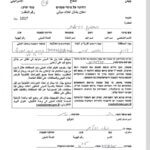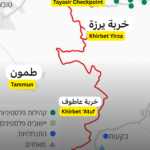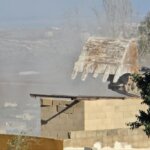Al Jazeera: Israel restricts Jordan Valley water access
Dalia Hatuqa Al Jazeera 28 Jul 2012
Palestinian communities in the Jordan Valley are frequently denied permits to restore old wells or dig new ones.
At a time when the Palestinian Authority is facing a severe financial crisis, a report by the UK-based non-governmental organisation Oxfam International has revealed that Palestinians could generate an extra $1bn a year by some estimates if Israel removes restrictions on the use of land, water and movement in the Jordan Valley.
“The Jordan Valley… has the potential to be the Palestinian bread basket,” the organisation said in the report, On the Brink: Israeli settlements and their impacts on Palestinians in the Jordan Valley. “However, the persistent expansion of Israeli settlements and other restrictions on Palestinian development have made life extremely difficult for Palestinian communities.”
The Jordan Valley and Dead Sea area holds nearly one-third of the West Bank’s land and is home to roughly 60,000 Palestinians. Under the 1993 Oslo Accords, which delegated various degrees of autonomy to the Palestinian Authority (PA) around built up and urban areas, Israel retained full civil and military control over 60 per centof the West Bank. This is now known as Area “C”. Some 87 per cent of the Jordan Valley lies within this classification. Area “A” is defined as under full PA control and Area B is under Israeli military control; the PA here is in charge of civilian affairs. These designations have effectively divided the West Bank into three main non-contiguous areas.
Permits denied
This was the case in Al Aqaba, a herding and agricultural community located on the Western edge of the Jordan Valley. Before 1967, around 2,000 Palestinians lived in this small village. There are fewer than 300 inhabitants today, after Israeli authorities created three military camps on its outskirts, and began military “training exercises” – using live ammunition – often within the village itself. Palestinian residents of the Jordan Valley are mainly farmers or Bedouins, mostly living in enclaves hemmed in by closed Israeli military zones, checkpoints and more than 30 Israeli settlements. Their movement is severely hindered by a stringent permit system and by “live fire” zones. Here, the Israeli military sometimes carries out training exercises in close proximity to Palestinian communities – and even inside population centres and villages.
Paralysed from the waist down after he was shot by Israeli soldiers, Al Aqaba’s mayor, Haj Sami Sadeq, led a campaign for years against these operations in order to sustain the existence of the village.
In 2001, the Israeli High Court ruled that Israeli soldiers must stop using Al Aqaba’s land for training exercises, and remove one of their military camps located at the entrance of the village.
But Mayor Sadeq said this wasn’t enough. “The village is constantly under the threat of extinction. Its land is constantly being confiscated, its homes demolished, its crops burned and there is often little access to water,” he said.
In 2003, Israeli authorities began issuing demolition orders against most of Al Aqaba, including the nursery school,medical centre, mosque and nearly all the homes. The village council turned once more to the Israeli High Court, which upheld the orders, saying the buildings – owned and built by Palestinians on Palestinian land, albeit within “Area C” – had been constructed without permits issued by Israeli officials.
According to Sadeq, the village had submitted several “master plans” to Israeli authorities to get these permits, one of which dates back to 1998. “The Civil Administration rejected the [latest] master plan a few days ago, and gave five more families in Al Aqaba demolition petitions,” he said.
Permits are rarely given to Palestinians, even for structures such as tents and water containers. Because of this restrictive planning system, most Palestinians are forced to build without a permit, knowing that their structures might be demolished at any time.
The UN Office for the Coordination of Humanitarian Affairs (OCHA) documented that, in 2011, Israeli authorities demolished 200 Palestinian structures in the area, including water tanks and homes made out of metal and plastic sheets, displacing 430 people and affecting the livelihoods of 1,200 others.
Israel’s systemic policy
According to OCHA, 90 per cent of demolitions occur in agricultural and pastoral communities in Area C. Khalil Tafakji, director of the Mapping and GIS Department at the Jerusalem-based Arab Studies Society, said: “Israel’s goal is [to] use the Jordan Valley as a way to control Palestinian space.” He cites several methods of “control”, including designating areas as closed military zones, nature reserves and settlements.
“Palestinians need a strategic plan to safeguard the area, similar to the one we have for Jerusalem. We need to make the Jordan Valley a national priority,” Tafakji said.
UN agencies and Israeli human rights groups have concluded in several reports that Israel has imposed a policy designed to restrict the development of the Palestinian communities in the area.
According to Israeli human rights group, BIMKOM: Planners for Planning Rights: “The restrictive Israeli planning policy is a central tool in the ongoing struggle for control of land and the [Israeli] Civil Administration’s attempt to secure large reserves of land for Israeli interests, primarily for the settlements.”
In the meantime, settlement activity has continued unabated, rising by 20 per cent in 2011 across the West Bank as compared with 2010, according to Oxfam. In the same period, the number of Palestinians displaced by demolitions reportedly doubled, with 60 per cent of these demolitions carried out in areas close to settlements.
Control of water sources
The Jordan Valley is home to some of the most fertile land in all of the occupied territories and Israel itself. Arable farming is deemed a lifeline for many rural Palestinian communities, yet Israel controls most water sources in the area, and 28 of its 42 drillings in the area in the Jordan Valley, according to B’Tselem.
The situation is far worse for those not connected to a formal water system, such as Bedouin communities, who are forced to buy bottled or tanked water at inflated prices.According to OCHA, families living on tanked water pay up to 400 per cent more for every litre than those connected to a water network. Palestinians in the Jordan Valley have very little access to water, living on 10-20 litres a day, far less than the 100 litres recommended by the World ealth Organisation. In comparison, residents of Britain use around 150 litres a day, according to the UK Environment Agency.
In contrast, the 9,500 Israeli settlers living in the Jordan Valley and Dead Sea area use roughly 300 litres per person per day, according to OCHA. This is more water per capita than the average household inside Israel is allocated, B’Tselem said: “The generous [water] allocation to the settlements has enabled [settlers] to develop intensive agriculture that operates year round.”
Palestinian communities in the Jordan Valley are frequently denied permits to restore old wells or dig new ones, while Israeli authorities also often destroy water cisterns and confiscate tanks. The latest incident occurred last month in Ein El Hilweh, a Jordan Valley pastoral community whose water storage tanks were confiscated.
B’Tselem estimates that the Palestinians have access to 89 wells in the area, down from 209 before 1967. “The reduction in the amount of water accessible to Palestinians [has] led to a decline in the amount of land cultivated by Palestinian and to a drop in competitiveness of the crops they grow,” the Israeli group said.
Israel under pressure
Earlier this week, Israel responded to OCHA’s ongoing work in the Jordan Valley and Area C by threatening sanctions against the organisation and formally asking for clarifications on its mandate. Israel is accusing the UN agency of supporting “unauthorised building” by Palestinians in Area C.
Oxfam called upon the European Union and its member states to pressure Israel to “end the construction of illegal settlements and [to] comply with its responsibilities under international law”.
The recommendation followed a statement made by EU foreign ministers, who called upon Israel to alleviate living conditions of Palestinians living in Area C, “by accelerated approval of Palestinian master plans, halting forced transfer of population and demolition of Palestinian housing and infrastructure, simplifying administrative procedures to obtain building permits, ensuring access to water and addressing humanitarian needs”.
Israel has repeatedly said that the Jordan Valley is essential to its long-term security. In March 2012, Binyamin Netanyahu said Israel would never withdraw from the Jordan Valley under any future peace agreement signed with the Palestinians. He said the strategic importance of the area along the eastern border of the West Bank prevented Israel from doing so.
In February, the Israeli Foreign Minister Avigdor Lieberman was quoted by the Jerusalem Post as saying: “We cannot secure the state of Israel without maintaining control of the Jordan Valley.”
Many Israeli leaders often cite Yigal Allon, a former Israeli general and deputy prime minister, who, in 1967, outlined a plan to control the Jordan Valley in order to act as a buffer area between Israel and its neighbours.
Yet some Israeli experts say that in the age of long-range missiles, securing a specific geographic area may not be as relevant as it was years ago. Hebrew University political science professor Yaron Ezrahi said Netanyahu was probably aware of this, “but he won’t say it because it would weaken his land-grabbing policy”.
However, “Players like al-Qaeda work by infiltration and terror. And here, borders are important, because we see instability in Jordan. We see demonstrations there and the king is facing some troubles. Instability creates questions about borders.”
Meanwhile, Mayor Sadeq and the residents of Al Aqaba are still entangled in legal battles that will determine the future of their village. Home demolitions in the Jordan Valley continue at a record pace while Israeli settlements continue to expand, taking control of water and land resources.






